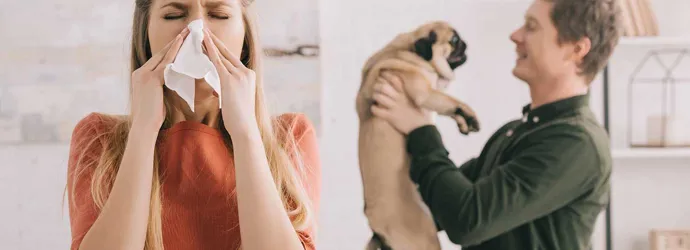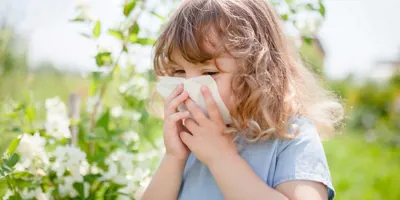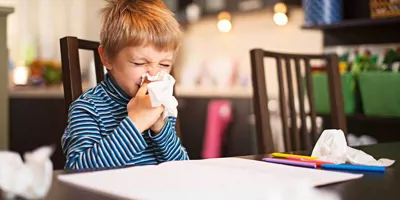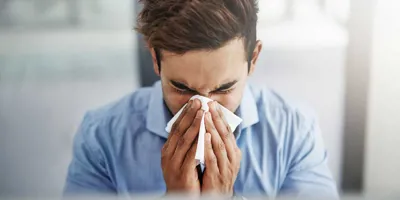1 person found this helpful

They say a dog is a man’s best friend, but not so much if you suffer from a dog allergy and come across them in your everyday life! However, just because you have an allergy to dogs, that doesn’t mean that you can’t control it. With our useful guide about the symptoms of dog allergies, and dog allergy remedies, you can stop it getting in the way of your day.
What is a dog allergy?
In simple terms, a dog allergy is caused by allergens being released, which in turn triggers an immune response that leads to irritating symptoms.
One of the most common misconceptions is that allergies are caused by dog hair. Allergy symptoms are more often produced as a result of dander (dead skin flakes) clinging onto the hair, rather than the hair itself. Urine and saliva can also cause allergic reactions, but dander on dog hair is the most common cause.
But what does a dog allergy feel like?
There are a number of dog hair allergy symptoms (and signs of a dog allergy in general) that may cause you irritation. Here are some of the most common symptoms:
- Red itchy eyes.
- Sneezing.
- Scratchy throat, which can lead to dog allergy symptoms like wheezing.
- Itchy, runny nose.
Should you find yourself experiencing any or all of these symptoms when near dogs, it could well be due to allergies. If you’re not sure whether you have an allergy to dogs or not, you can seek medical advice, and maybe even get an allergy test to check.
It’s a good idea to keep a packet of Cushelle Tissues with you, for those occasions when you know you might come into contact with dogs. They’ll provide comfort and catch the inevitable sneezes – the perfect pooch-protection companion.
Dog allergy prevention
Whether there’s a dog in your home or you have friends and family who have a dog, it’s useful to know how to prevent dog allergy symptoms flaring up. These tips should help:
- Make sure any dog in your home is thoroughly bathed and brushed on a regular basis.
- Keep your carpets clean and use a quality vacuum to get rid of hair and dander.
- Keep petting and stroking down to a minimum and wash your hands straight after contact.
- Change and wash your clothes after contact.
- Restrict the dog to certain rooms in your home.
- Use an air filter.
- Take medicines – but only on the advice of your health professional.
Depending on the level of your allergy, you can take appropriate steps to keep the effects to a minimum. If you’re dealing with dog hair allergy symptoms, you now know what to do ––and being allergic to dog hair shouldn’t be as restricting as it once was!
Related articles
Pollen allergy in children: How to cope with kids’ hay fever
The symptoms of pollen allergy in children can be tackled. Click here for tips on how to treat hay fever in children.

Runny nose remedies: 6 ways to stop a runny nose
Looking for a runny nose remedy you can make at home? For five family-friendly ways to stop a runny nose, click here.

5 Home Remedies for a Tickly Cough
SOS: Tickly cough home remedies needed! Here at Cushelle we've put together a few tips to get rid of a tickly cough: from honey to soup, read on for more!

What Causes Puffy Eyes? Causes and Treatments
Looking for a swollen eye allergy treatment? Need to know what to do for swollen eyes? Try our list of swollen eye allergy home remedy ideas.

Sneezing 101: Why do we sneeze and is sneezing good for you?
What does sneezing do? If you’ve been wondering is sneezing good for you, or the reasons behind why we sneeze, expand your knowledge here.

How to cough and sneeze properly to avoid the spread of germs
With our easy sneezing rules you’ll know how to sneeze without spreading germs. Learn how to cough and sneeze safely here!



